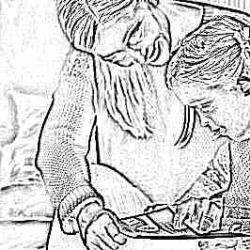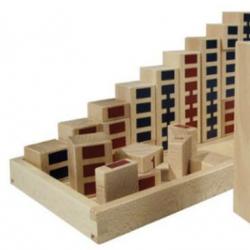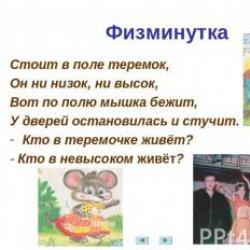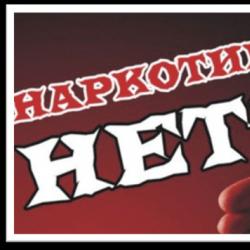Abstract of the lesson on teaching literacy “Sound. Letters A, a. Summary of the lesson on the topic "Sounds and, the letter B, in" "Lessons in correct speech and correct thinking"
Explain the correct correct fit, the position of the notebook on the desktop, the position of the pen in the hand.
Analyze features of the correct fit, the position of the notebook and the position of the pen in the hand when writing with the right and left hand.
Fulfill finger gymnastics and gymnastics for hands.
navigate in terms of "left", "right", "left", "right", "top", "bottom".
Find specified position on the worksheet.
Fulfill instruction of the teacher to draw lines starting and ending at given points.
navigate to the starting point of the movement, to the arrow indicating the direction of movement.
Conduct lines from a specific point in a given direction.
Analyze element-by-element composition of printed and written capital and small letters.
Compare uppercase and lowercase letters.
Compare uppercase and lowercase letters.
Compare inscriptions of printed and written letters (uppercase and lowercase).
Simulate letters from a set of elements, various materials (wire, plasticine, etc.).
Analyze deformed letters, identify missing elements, reconstruct letters.
Compare written letters with the spelling pattern proposed in the copybook and on the board.
Distinguish letters that have optical and kinetic similarities.
Control own actions: paint over only those parts of the picture that have a given letter, choose the best of the written letters.
Write printed and written upper and lower case letters.
Write letters, syllables, words, sentences in compliance with hygiene standards.
Participate in the development of criteria for evaluating the written.
Evaluate own writing, taking into account the developed criteria (legible, neat lettering).
Group letters by the presence of certain elements in them; by the similarity of the sounds they designate (voiced - deaf consonant sounds, etc.).
Find in texts words with a given letter.
correlate words written in print and script.
Spread words from the split alphabet.
Write down under dictation separate words and sentences consisting of three to five words with sounds in a strong position.
Explain characteristics of legible neat writing.
Simulate in the process of joint discussion of the cheating algorithm.
Use algorithm for the order of actions when cheating.
Write off words, sentences, small texts written in printed and written font in accordance with a given algorithm.
Control stages of your work.
Write sentences with spaces between words.
Use transfer sign.
Primer 1 class.
Lesson topic: Alphabet
The purpose of the lesson: to form students' understanding of the alphabet.
Tasks:
Educational: to systematize students' knowledge of the alphabet; repeat the spelling of previously studied letters; continue the formation of the concept of "sound-letter".
Developing: develop phonemic hearing; to develop in students the ability to highlight the main thing, to draw conclusions.
Educational: to cultivate love for the Russian language.
Equipment: computer, projector
Teaching methods:
explanatory and illustrative
search and research.
Expected results:
1) understands why the alphabet is needed and its role in people's lives:
2) knows how to use the alphabet in practice, correctly arranges words in alphabetical order;
During the classes:
I. Organizational moment.
Greetings, checking readiness for the lesson.
To study well
There is a lot to know.
Every year a piggy bank of knowledge,
Definitely replenish.
We have an unusual lesson today. We will go on a journey through a large country called "Bukvarinsk".
II. Knowledge update. Station "Remember"
1. Front work. Tape of letters (Slide)
How is a sound different from a letter? (We hear and pronounce the sound, but we write and see the letter).
How to distinguish a vowel from a consonant? (When pronouncing, the vowel sound does not encounter an obstacle).
Name the letters that represent vowel sounds.
What letters can represent two sounds? (E, Yo, Yu, I)
What letters indicate the softness of a consonant? (E, E, Yu, I, I, b)
What letters always represent a soft sound? (H, W, Y)
Which letters do not represent sounds? (b, b)
III. Learning new material.
Guys, the next station is "Think". We need to collect the word. (Alphabet)
1) How the word "alphabet" was formed.
2) What is the alphabet for?
3) Where is the alphabet used?
The word "alphabet" comes from the Greek language. The first letters were called "alpha" and "vita". From these two names came the word "alphabet". And it means that all the letters are arranged in the prescribed order. Each letter has its own permanent place and name.
Working with the textbook.Reading the letters of the Alphabet.
What is the alphabet for?
It is necessary to use the alphabet when compiling any lists (for example, in a class magazine - the names of students), when arranging books in the library (by the name of the author of the book, and in case of its absence - by the first letter of the title), when storing forms, subscriptions in the library, when compiling card indexes and catalogs (lists of publications).
Do you think it's convenient? Why? (Quickly finds the student's last name, based on the "alphabet").
Where else do you think the alphabet is used? (The alphabet is used to compile dictionaries, various directories, catalogs. In the registry of the clinic, where medical records are at the addresses and by the names of the patients (in strict observance of the alphabetical order).
Using the alphabet, you can put words in a certain order, i.e. alphabetically. (Slides)
Reading a poem in a textbook.
IV. Consolidation.
1. Practical use of the alphabet. Insert the missing letters. Pick up apples. (Slide)
3. Pair work. Arrange the seasons in alphabetical order: winter, spring, summer, autumn. (Slide).
VI. Control of acquired knowledge. (Independent work).
Write down the words alphabetically. (Slides)
Magic bag game
Build a word from letters. (homeland)
Sound-literal analysis of the word Motherland. (signal cards)
VII. Summary of the lesson. Reflection.
What have you learned?
What is an alphabet?
What did you do in class?
VIII. Homework.
Topic: “Sounds [s], [s]; letters s, sTasks:
Educational - acquaintance of students with the letters C, with and the sounds [s], [s]; Developing - acquiring the skills of fluent, conscious reading;
Educational - aesthetic education by means of fiction (fairy tales)
Equipment: snowflake, sleigh, poems, schemes, fairy tales, pictures.
During the classes
1. Organizational moment.
2. New theme:
Introductory conversation. - Guys, look, something fell into my palm.
Falling from the sky in winter
And circle over the earth
soft fluff,
Lovely snowflakes.
(The teacher opens his hand and shows a "snowflake")
- Look out the window. Everything is covered around with white fluffy snow. Let's show how the snowflakes are spinning.
(Children slowly raising and lowering their hands spin around)
- Today we have a holiday of a new letter. What are we going to the fabulous
country of ABC studies? (sledging). But the magic sleigh can only appear when you correctly map out the word "sleigh".
Children make a chart.
- What is the same sound in the words "snow", "snowflakes", "sled"? (sound [s].)
- What other "snow" words do you know? (Snowman, snowman, etc.)
Before getting into the magic sleigh, you need to repeat the tongue twister three times:
“Seven of them got into the sleigh themselves.” (Children speak).
And now we are going to the winter ... forest
Ah, guys, you need to guess where we are going, because our word has lost its sound. Help, otherwise the sled will not go!
On the yellowed grass
The lion (forest) throws its foliage.
That's right, forest. What forest are we talking about here? And we will go to the winter forest. Hold on tight!
3 Physical minutes
We sit on sleds
And we quickly rush down the hill.
Snow, snow, white snow!
We run the fastest!
Then everyone ran into the forest,
And we started playing snowballs.
(During a physical minute, children squat, quickly walk in place,
Holding hands behind, then imitate a snowball fight.)
4. Working with sound
-And now, guys, you will “not just play snowballs”, but at each throw, at my request, name any word with the sound [s] and determine the place of this sound in the word.
(Game in progress)
- Well, we played and again we sit down in the sleigh. We are going through the winter forest. How
you think all birds fly to warmer climes. Let's listen.
(Against the background of silence, the teacher begins to read poetry.)
Where the finches sang
Today, look
Like pink apples
On the branches of snowmen.
And in the forest, mind you, children,
There are night watchmen.
The watchmen are afraid of these -
The mice hide, shivering.
Owls and owls are very severe.
Think of other birds that have this sound in their names.
(Guessing riddles about a titmouse, a starling, a magpie.)
- Who knows the fairy-tale characters with the letter C?
Fairy tales ask: - And now
You friends, get to know us.
There is no river or pond
Where to drink water?
Very tasty water
In the hoof hole! …
("Sister Alyonushka and brother Ivanushka")
The red girl is sad
She doesn't like spring
She's hard on the sun
Tears pouring poor thing
("Snow Maiden")
Remember the fairy tale about the Snow Maiden? (Children talk)
Guys, why did the Snow Maiden turn into a cloud in the fairy tale?
(children's answers)
-Look, we also have a “bonfire burning”.
(In the picture there is a flame of a fire, in the languages \u200b\u200bof which the syllables merge sa, so, su, sy, syn. Children read.
5. Homework
6. Summary of the lesson
The teacher opens a beautiful package tied with a blue ribbon and takes out emblems with the image of the Snow Maiden. Children should circle the letters Cs, written in dotted lines, with a pen. This is a gift from the Snow Maiden.
- Guys, what did you like today's lesson?
- How to make it better?
Primary school teacher
Tusupbayeva Zhanar Toktarbekovna
Semey Chekoman secondary school
Among the huge selection of methods, teaching reading according to the method of Nadezhda Zhukova is very popular. Her method is adapted for self-study of parents with children at home. N. Zhukova's textbooks are affordable, they can be purchased in almost all bookstores. Let's try to figure out what is special about this technique and why it is so popular.

From the biography
Nadezhda Zhukova is a familiar domestic teacher, candidate of pedagogical sciences, has extensive speech therapy experience. She is the creator of a whole series of educational literature for children, which is published in millions of copies. Many of her scientific works have been published not only in Russian, but also in specialized publications in other countries.
Nadezhda Zhukova conducted many studies with preschool children, carefully studied the progressive processes of their speech development. She has created a unique method by which children can quickly learn to read and easily move from it to writing. In her methodology, N. Zhukova teaches children to correctly add syllables, which she uses as a single part in reading and writing in the future.

Sales of her modern Primer exceeded 3 million copies. From these figures, according to statistics, we can conclude that every fourth kid learns to read according to him. In 2005, he was awarded the title of "Classic Textbook".
In the 1960s, Nadezhda Zhukova was an active member of the initiative group, which dealt with the creation of specialized groups for children with speech problems and disorders. Now such speech therapy groups and entire kindergartens with this bias are widespread not only in our country, but also in the CIS countries.

Features of the technique
In creating her own special method, N. Zhukova used her 30-year speech therapy work experience. She was able to build a successful combination of literacy education with the ability to prevent children from making mistakes in writing. The textbook is based on the traditional approach of teaching reading, which is complemented by unique features.
In speech activity, it is psychologically easier for a child to single out a syllable than a single sound in a spoken word. This principle is used in the method of N. Zhukova. Reading syllables is offered already in the third lesson. In view of the fact that at the very beginning of learning to read, this process for children is a mechanism for reproducing the letter model of a word into a sound one, by the time learning to read, the baby should already be familiar with the letters.

It is not worth teaching with a child all the letters of the alphabet at once. The first acquaintance of the baby should be with vowels. Explain to the baby that vowels are singing letters, they can be sung. Start by learning the so-called hard vowels (A, U, O). After the kid got acquainted with them, you already need to start adding up: AU, AO, OU, UA, UA, OA, OU. Of course, these are not syllables, but it is on this combination of vowels that it is easiest to explain to the baby the principle of adding syllables. Let the baby himself, helping himself with his finger, draw paths from letter to letter, singing them. So he can read a combination of two vowels. Next, you can start memorizing consonants.
Then, when you begin to teach the baby to read, explain to him how to determine by ear how many sounds or letters you have pronounced, which sound in a word sounds first, last, second. Here you can help in learning "Magnetic alphabet" N. Zhukova. With its help, you can ask the baby to lay out the syllables pronounced by you.
You can also feel the letters, circle them with your finger, which will contribute to their tactile memorization. When the baby learns to merge syllables, you can offer him to read a word of three letters, a word of two syllables. (O-SA, MA-MA).

In Zhukova's "Primer" parents will be able to find mini-summaries of classes for the study of each letter, recommendations for teaching the folding of syllables. Everything is written in accessible language. In order to use them, parents do not need to have a pedagogical education. Any adult can take the course.

A preschooler is able to perceive information only in a playful way. The game for him is a calm environment where no one will scold or criticize him. Do not try to force the child to quickly and immediately read syllable by syllable. For him, reading is hard work. Be patient, show affection and love for the baby during training. It matters to him now more than ever. Showing calmness and confidence, learn to add syllables, simple words, sentences. The child must master the technique of reading. This process is not fast and difficult for him. The game diversifies learning, relieves the boring obligation to study, and helps instill a love of reading.
 Your patience and calmness will help your child learn to read faster.
Your patience and calmness will help your child learn to read faster.
Starting age
You should not rush things. It is quite normal that a 3-4-year-old child is not yet able to learn at all. During this age period, it is possible to start classes only on the condition that the child shows great interest in reading activity, shows a desire to learn to read.
A 5-6-year-old child will react to this in a completely different way. In preschool institutions, the curriculum is designed to teach children to read in syllables. However, not always the kids can learn the information received in a large team. Many children require individual lessons in order for them to understand the principles of folding syllables and words. Therefore, do not miss the opportunity to work out with your child at home. Having come to school well prepared, it will be easier for the baby to endure the adaptation period.
It is important to take into account the psychological readiness for learning to read. Children are ready to start reading only if they already speak well, correctly compose sentences in their speech, phonemic hearing is developed at the proper level. Babies should not have problems with hearing and vision, speech therapy problems.
 Reading training should begin at the age when you see the interest of the baby and feel that he is ready.
Reading training should begin at the age when you see the interest of the baby and feel that he is ready.
Sounds or letters?
Acquaintance with letters should not begin with memorizing their names. Instead, the child must know the sound that is written by a particular letter. No EM, ER, TE, LE, etc. should not be. Instead of EM, we learn the sound "m", instead of BE, we learn the sound "b". This is done to make it easier for the child to understand the principle of folding syllables. If you learn the names of the letters, then the child will not understand how the word PAPA is obtained from PE-A-PE-A, and the word MAMA is obtained from ME-A-ME-A. He will add not the sounds that are indicated by letters, but the way he learned - the names of the letters and, accordingly, will read PEAPEA, MEAMEA.

Learn the correct vowels and consonants
Don't start learning the letters in alphabetical order A, B, C, D... Follow the sequence given in the Primer.
First of all, learn the vowels (A, O, U, S, E). Next, the student should be introduced to the solid voiced consonants M, L.
Then we get acquainted with deaf and hissing sounds (K, P, T, W, H, etc.)
In the "Primer" N. Zhukova proposed the following order of studying letters: A, U, O, M, C, X, R, W, Y, L, N, K, T, I, P, Z, Y, G, V , D, B, F, E, b, I, Yu, E, H, E, C, F, W, b.
 The sequence of studying letters presented in Zhukova's primer will help you easily adjust to the school curriculum
The sequence of studying letters presented in Zhukova's primer will help you easily adjust to the school curriculum
Reinforcing learned material
The repetition of previously studied letters in each lesson will contribute to the faster development of the mechanism of literate reading in children.
Reading by syllables
Once you and your child have learned a few letters, it's time to learn how to add syllables. A cheerful boy helps in this in the "Primer". It runs from one letter to another, forming a syllable. The first letter of the syllable must be pulled until the baby traces the path along which the boy is running with his finger. For example, the syllable MA. The first letter M. We put a finger at the beginning of the track near it. We pull the sound M while we run our finger along the track, without stopping: M-M-M-M-M-A-A-A-A-A-A. The child must learn that the first letter stretches until the boy runs to the second, as a result they are pronounced together, without breaking away from each other.

Starting with simple syllables
The child must understand the algorithm for folding syllables from sounds. To do this, he needs training first on simple syllables, such as MA, PA, MO, PO, LA, LO. Only after the child understands this mechanism, learns to read simple syllables, you can proceed to more difficult syllables - with hissing and deaf consonants (ZHA, ZHU, SHU, XA).

The stage of learning to read closed syllables
When a child learns to add open syllables, it is necessary to start learning to read closed syllables, i.e. those with a vowel in the first place. AB, US, UM, OM, AN. It is much more difficult for a child to read such syllables, do not forget about regular training.

Reading simple words
When the child understands the mechanism of folding syllables, begins to read them with ease, it's time to read simple words: MA-MA, PA-PA, SA-MA, KO-RO-VA.
Pay attention to pronunciation and pauses
In the process of learning to read, it is necessary to carefully monitor the pronunciation of the child. Pay attention to the correct reading of the endings of words, the child should not guess what is written, but read the word to the end.
If at the initial stage of training you taught the child to sing syllables, now, the time has come to do without it. Make sure your child pauses between words. Explain to him what punctuation marks mean: commas, periods, exclamation and question marks. At first, let the pauses between the words and sentences that the baby makes be long enough. Over time, he will understand and shorten them.
By following these simple rules, you can teach your child to read pretty quickly.

Popular books for children by N. Zhukova
In order for parents to be able to teach their child to read and write using her methodology, Nadezhda Zhukova offers a whole series of books and manuals for children and parents.
This includes:
"Primer" and "Recipes" for children 6-7 years old in 3 parts
Copybooks are a practical application to the Primer. The syllabic principle of graphics is adopted as a basis. The syllable is a separate unit not only of reading, but also of writing. The recording of the vowel and consonant letters acts as a single graphic element.


"Magnetic alphabet"
Suitable for both home use and for classes in children's institutions. A large set of letters allows you to make not only individual words, but also sentences. Methodical recommendations for work are attached to the "ABC", they are supplemented with exercises for teaching children.

"I write correctly - from the Primer to the ability to write beautifully and correctly"
The textbook is suitable for children who have already learned to read syllable by syllable together. It is also necessary that the kids can determine the first and last sounds in a word, can name words for the sound that they were called, indicate the place of a given sound in a word - at the beginning, in the middle or at the end. The book is designed to express the creativity of the teacher who deals with it. The proposed sections can be expanded or narrowed, the number of oral and written exercises varies by the teacher. At the bottom of some pages you can see methodological instructions for conducting classes. A lot of plot pictures offered as illustrations for the textbook will help the child not only easily learn the basic principles of grammar, but also develop oral speech.

"Lessons of Right Speech and Right Thinking"
The book is suitable for children who already read well. Here, texts of the classical genre are offered for reading. For parents, there is a detailed methodological description of classes based on the book. For each work, a system of work on the text is attached for its analysis. With its help, children learn to reflect, understand the hidden subtext, explain, discuss. You can also see the meaning of words unknown to the child, which are in the dictionary for children. Also the author introduces kids to famous poets and writers, teaches them to read this or that work correctly.

"Lessons of calligraphy and literacy" (teaching copybooks)
A manual that complements the rest of the elements of N. Zhukova's system. With the help of it, the child will be able to learn how to navigate on the sheet, work according to the model, circle and independently write various elements of letters and their connections. Tasks are offered for sound-letter analysis of words, adding missing letters in a word, writing uppercase and lowercase letters, etc.






